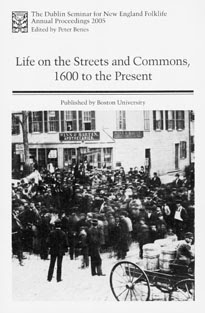
I’ve added a new term to the topics list at the lower right:
deathways. I’ve been looking for a term to cover several related topics: deaths, funerals, memorials. At this past weekend’s
Omohundro Institute conference, a paper by
Erik Seeman reminded me of that useful, if anachronistic, umbrella term.
Prof. Seeman’s paper looked at certain deathways—coffins and grave markers—linked to
people of African descent in eighteenth-century America. His examples came from segregated burying-spaces. In
New York, the
Trinity Churchyard was closed to blacks in 1697, forcing the creation of what’s now called the
African Burial Ground. Newport also had a
burying-ground for people of African descent, and the marker above comes from it.
In Boston, however, blacks and whites seem to have been interred in the same burying-grounds.
Crispus Attucks was put in the same vault with other victims of the
Boston Massacre, though of course he might have been a special case. The
example of John Jack in
Concord, other anecdotes, and the lack of contrary evidence indicate that colonial Massachusetts deathways didn’t include separate burials for blacks.
The first hint of such separation that I’ve stumbled across comes several years after the Massachusetts courts, in what conservatives would term “judicial activism,” ruled in 1783 that the state’s constitution
didn’t allow slavery. Over the next decade, I believe, African-Americans tried to feel out their place in Boston society, seeking either equal treatment in the white-dominated institutions or (more often) autonomy for black-dominated ones. And that effort seems to have affected their funerals, though it’s not clear how.
On 7 Sept 1791, the selectmen responded to “a number of Free Negroes” who had asked to select an “Undertaker at the Funerals of the Blacks.” The selectmen refused, saying that would interfere with the work/income of the church sextons. The African-Americans renewed their request a year later. On 25 Sept 1792 the selectmen’s records state:
On the Petition of the Blacks that Henry Richard Stevenson, may have the care of burying the Blacks—Voted that the said Stephenson have a License to take care of the Funerals of the Blacks, in all respects except breaking Ground.
Not all was settled, however. Years later, on 25 Apr 1798, the selectmen summoned Stevenson and a colleague after some sort of complaint:
Stephenson & Boston Faddy, who have been employ’d in burying Negroes attended—& being heard after enquiry of Mr Blaney—finding that Stephenson had behaved to his —— [directions? satisfaction?] was permitted to proceed agreable to former directions untill further Orders—& Boston forbid to bury any Corps without particular direction obtain’d therefor of the Selectmen—
All these quotations are from the
27th volume of the published Boston town records. Alas, they offer only the thinnest of clues to what the citizens and selectmen were thinking.
Henry Stevenson is otherwise known largely through the records of Boston’s
Trinity Church. He and another black man were baptized there on 13 July 1788, with
Prince Hall being one of the sponsors. On 26 October, Stevenson married Hannah Patterson, and she was baptized on 9 November. Over the following years, Stevenson sponsored the baptism of several other African-Americans. The 1790 census lists “Henry Stephinson” as head of a Boston household consisting of two non-white free people.
Boston Faddy was also linked to the town’s Anglican churches. He was buried by
King’s Chapel on 26 Dec 1801, his age stated as “50 years,” meaning he had been born about 1751. The earliest record of Boston Faddy, however, relates to the baptism of his son James Buffum on 13 Apr 1789. His wife Nancy and a man named Cuff Buffum were the other sponsors. In 1795, Faddy sponsored the baptism at Trinity Church of a son of
George Middleton.
On 31 Aug 1792, Faddy’s daughter was buried out of Trinity, and in August 1794 young James died. On 24 Oct 1796, Nancy Faddy was buried at King’s Chapel, her age listed as fifty-one. In 1797 and then again in 1801 there are records of Faddy filing intentions to marry Mary Freeman, the latter only a few weeks before he died. A 1798 tax list recorded Boston Faddy as owner of a property in the West End valued at $300; Cuff Buffum was living there. Faddy’s profession was “bell-ringer,” according to Jacqueline Carr’s
After the Siege.


